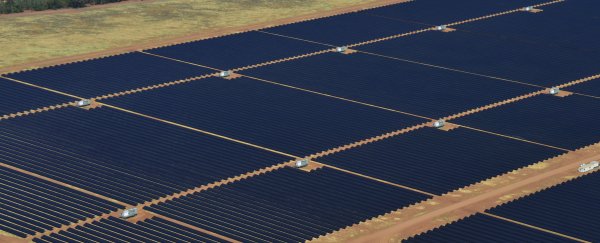Australia's largest solar power plant, located in a small town called Nyngan about 550 km northwest of Sydney, has been switched on, and is now feeding power to the national electricity grid.
According to energy company AGL, which has built the plant, the electricity is coming from a section of the solar plant which consists of approximately 350,000 solar photovoltaic (PV) modules.
This means that large-scale solar is, for the first time, making a modest impact on Australia's power supply profile.
If you check this graph at RenewEconomy, you can see the real-time contribution from the new solar plant. It's the barely noticeable sliver of orange on the far right of the bar representing the state of New South Wales (NSW).
It's slightly depressing, given the sea of mostly black, coal-fired generation that comprises the bulk of electricity in the state - and the country, for that matter - but it's an important step forward, considering Australia emits more carbon pollution per capita than any other developed country, and the electricty sector is responsible for a third of these emissions.
Importantly, Australia could see more large-scale solar infiltrating the grid soon. The solar farm in Nyngan is currently operating at less than a quarter of its planned 102 MW capacity. The $290 million project is expected to be fully operational sometime in July 2015.
And a 53 MW sister solar farm is also being built by AGL, in conjunction with First Solar, in the town of Broken Hill, NSW - about 1,100 km west of Sydney, close to the border of South Australia.
The two solar farms at Nyngan and Broken Hill will produce approximately 360,000 megawatt hours of electricity per year once fully operational, "which will be sufficient to meet the needs of over 50,000 average NSW homes," says AGL.
"First generation at Nyngan represents an important milestone, especially as it relates to the broader power sector's adoption of utility-scale solar as a meaningful contributor to Australia's generation mix," said Jack Curtis, who is the Asia-Pacific Manager for First Solar, in a press release.
AGL is constructing both solar farms with $166.7 million funding support from the Australian Renewable Energy Agency (ARENA) and $64.9 million from the NSW Government.
There has been widespread uncertainty for investors in the renewable energy sector in Australia, after a controversial review of the country's Renewable Energy Target was carried out in 2014.
This review recommended scrapping the current target of 20 percent renewable generation by 2020 - which had bipartisan support when it was passed - or else winding the target back dramatically.
The result of this review has so far been political deadlock over possible amendments, which has been pretty damaging to the large-scale renewable energy industry in Australia.
According to Bloomberg New Energy Finance, investment in large-scale renewables in Australia plummeted in 2014, down 88 percent from 2013, to a 10-year-low of $240 million.
This downturn saw Australia slide from the 11th largest investor in large-scale clean energy to the 39th largest, behind countries such as Honduras and Costa Rica.
As Giles Parkinson for RenewEconomy reports, "it is thought that there are several dozen large-scale solar projects in planning mode – ranging from several MWs to mega projects such as a 2GW plan for western Queensland, but most are on hold because of uncertainty about the renewable energy target."
Hopefully, the Australian government can get the industry back on track, and we can see more large-scale renewable projects delivering more clean energy moving forward.
Source: RenewEconomy
